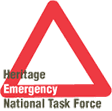Heritage Emergency National Task Force
Hurricane Ike Conference Call
October 10, 2008
Larry Reger of Heritage Preservation convened the call and requested updates on hurricane damage by state, as well as information on current funding and response initiatives. There were representatives on the call from Illinois, Louisiana, and Texas.
FEMA UPDATE
Alan Aiches, Historic Preservation Specialist at the Federal Emergency Management Agency (FEMA), reported that FEMA has received information about collections affected by the storm, but is just beginning to investigate damage to historic structures. Galveston was hit the hardest, with the Lone Star Flight Museum and the Rosenberg Library suffering the most damage. Areas north of Galveston and around Houston have faired well, with power outages being the main issue. FEMA has been directing museums and libraries to start the recovery process and seek guidance on stabilizing collections from the American Institute for Conservation of Historic and Artistic Works (AIC) and Laura Casey, the Coordinator of the Museum Services Program at the Texas Historical Commission, at 512-463-6427.
STATE REPORTS
Texas. Gary Gibbs of the Texas Commission on the Arts stated that Humanities Texas took the lead after the hurricane and met with FEMA and the Texas Governor’s Division of Emergency Management. Together they made a plan for dealing with damage to the cultural resource community and made sure that resources were not being duplicated. Humanities Texas has submitted an emergency grant application to the National Endowment for the Humanities (NEH) for help with collections and rebuilding. Gibbs reported on two damaged theaters in Galveston, the Strand Theatre and the Grand 1894 Opera House. The Galveston Arts Center sustained damage as well, losing an entire exhibit that could not be removed in time.
The overall consensus was that since Galveston is still without power, conditions are extremely poor and not a lot of damage assessments can be completed. Transportation around the island is difficult, and many employees of cultural institutions are dealing with enormous personal losses.
Louisiana. Genny Nadler Thomas of the Louisiana Association of Museums reported that west and south of Baton Rouge, there is mostly tree and wind damage to roofs. Several historic buildings in the Rural Life Museum complex in Baton Rouge suffered tornado-related damage, which is estimated to exceed $250,000.
Illinois. Neil Kelley of the Illinois State Library talked about a school library and a public library near Chicago, both of which had water damage. He mentioned that the state has Library Services and Technology Act (LSTA) grants available for up to $4,900; the grants do not require a contract and can be processed very quickly.
FUNDING AND RESPONSE INITIATIVES
On-site Salvage Assistance. Eric Pourchot of AIC gave an update on his organization’s Collections Emergency Response Teams (CERT). An AIC-CERT team removed furniture with water damage from the Aston Villa in Galveston and advised the Lone Star Flight Museum, the Moody Mansion, and the University of Texas Medical Branch in Galveston. They also gave phone advice to the John Dillinger Museum in Hammond, IN, which experienced damage from excessive rain. AIC may be sending a conservator there to assess the situation next week.
Federal Agencies. Elizabeth Joffrion of the National Endowment for the Humanities stated that her agency is still monitoring the situation and gathering information, but has not launched a special initiative at this point. She encouraged institutions in affected areas to contact her directly at 202-606-8577.
In response to a question, Alan Aiches confirmed that rental costs for a new location to house collections that have been moved are reimbursable by FEMA. Alan provided his contact information for follow-up on this matter and any others: 202-646-2617, Alan.Aiches@dhs.gov. He stressed that all affected institutions—whether part of a government entity or not—should file a FEMA Request for Public Assistance as soon as possible. He added that the two theaters in Galveston mentioned on the call will be included in the building assessments that FEMA is starting, and he encouraged the libraries in Illinois to look into FEMA’s Operation Blue Roof.
Frank Adinolfe of the Small Business Administration (SBA) reminded everyone of the SBA loan program. This program requires a separate application from the FEMA Request for Public Assistance. SBA staff will assist applicants and readily answer questions. The application can be found on the SBA Disaster Assistance Web page, http://www.sba.gov/services/disasterassistance/index.html. FEMA and SBA funding policies are also summarized at http://www.heritagepreservation.org/federal/Index.html.
Disaster Funds. Peggy Rudd of the Texas State Library reported that the Texas State Library and Archives Commission expanded their available fiscal year funds, which allows for “Texas Responds” grants to help libraries in affected areas. For more information about this program, go to http://www.tsl.state.tx.us/ld/funding/responds/index.html.
Tom Connors of the Society of American Archivists (SAA) reported that the SAA and the Society of Southwest Archivists have established a National Disaster Recovery Fund for Archives, which is accessible at www.archivists.org/news/NDRFA.asp.
Larry Reger thanked everyone for their participation and reminded them to visit the Heritage Preservation Hurricanes and Tropical Storms 2008 Web page to find information resources and submit damage reports or requests for assistance. Since lack of power in Galveston is still making it difficult to complete damage assessments, the next conference call will not be convened for another 10 days.

